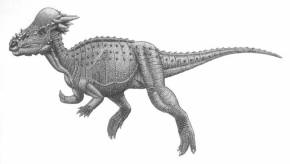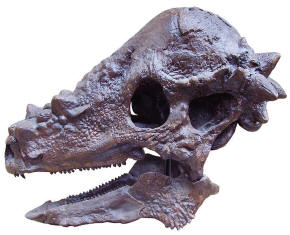suggesting that the animal
had good vision and was capable of binocular vision.
Pachycephalosaurus
had a small muzzle which ended in a pointed beak. The teeth were tiny, with
leaf-shaped crowns. The head was supported by an "S"- or "U"-shaped neck.
Pachycephalosaurus
was probably bipedal and was the
largest of the pachycephalosaurid (bone-headed) dinosaurs. It has been
estimated that
Pachycephalosaurus
was around 4.5 metres (15 ft) long and weighed 450 kilograms (990 lb). Based
on other pachycephalosaurids, it probably had a fairly short, thick neck,
short fore limbs, a bulky body, long hind legs and a heavy tail, which was
likely held rigid by ossified
tendons.
Classification and systematics
Pachycephalosaurus
gives its name to the
Pachycephalosauria, a
clade of herbivorous
ornithischian ("bird
hipped") dinosaurs which lived during the Late Cretaceous Period
in North America and Asia. Despite their
bipedal stance, they were likely more closely related to the ceratopsians than the
ornithopods.
Pachycephalosaurus
is the most famous member of the Pachycephalosauria (though not the
best-preserved member). The clade also includes
Stenopelix,
Wannanosaurus,
Goyocephale,
Stegoceras,
Homalocephale,
Tylocephale,
Sphaerotholus and
Prenocephale. Within
the tribe Pachycephalosaurini,
Pachycephalosaurus
is most closely related to
Dracorex and
Stygimoloch, although
these may be juvenile forms of
Pachycephalosaurus.
Discovery
and history
Remains attributable to
Pachycephalosaurus may
have been found as early as the 1850s. As determined by Donald Baird, in
1859 or 1860
Ferdinand Vandiveer Hayden,
an early fossil collector in the North American West, collected a bone
fragment in the vicinity of the head of the Missouri River, from
what is now known to be the
Lance Formation in
southeastern Montana. This specimen, now
ANSP 8568, was
described by
Joseph Leidy in 1872 as
belonging to the dermal armor of a reptile or
an armadillo-like animal.
Its actual nature was not found until Baird restudied it over a century
later and identified it as a
squamosal (bone from
the back of the skull) of Pachycephalosaurus,
including a set of bony knobs corresponding to those found on other
specimens of Pachycephalosaurus.
Because the name Tylosteus
predates Pachycephalosaurus,
according to the
International Code of Zoological Nomenclature
it should be preferred. In 1985, Baird successfully petitioned to have
Pachycephalosaurus
used instead of older Tylosteus
because the latter name had not been used for over fifty years, was based on
undiagnostic materials, and had poor geographic and stratigraphic
information.
P. wyomingensis,
the type and currently only
valid species of
Pachycephalosaurus,
was named by
Charles W. Gilmore in
1931. He coined it for the partial skull
USNM 12031, from the
Lance Formation of Niobrara County, Wyoming. Gilmore
assigned his new species to
Troodon as
T. wyomingensis. At the
time, paleontologists thought that Troodon,
then known only from teeth, was the same as
Stegoceras, which had
similar teeth. This misassignment to Troodon was corrected in 1945.
In 1943,
Barnum Brown and
Erich Maren Schlaikjer,
with newer, more complete material, established the genus
Pachycephalosaurus. They
named two species: Pachycephalosaurus grangeri,
the
type species of the
genus Pachycephalosaurus,
and Pachycephalosaurus reinheimeri.
P. grangeri was
based on
AMNH 1696, a nearly
complete skull from the
Hell Creek Formation of
Ekalaka,
Carter County, Montana.
P. reinheimeri was
based on what is now
DMNH 469, a dome and a
few associated elements from the Lance Formation of
Corson County, South
Dakota. Their two newer species have been considered synonymous with
P. wyomingensis since
1983.
Paleobiology
Nearly all
Pachycephalosaurus fossils
have been recovered from the
Lance Formation and
Hell Creek Formation of
the western United States. Pachycephalosaurus
co-existed alongside fellow pachycephalosaurs
Dracorex and
Stygimoloch. Other
dinosaurs that shared its time and place include
Thescelosaurus, the
hadrosaurid
Anatotitan, ceratopsid
Triceratops, ankylosaurid
Ankylosaurus, and the
theropods
Ornithomimus,
Troodon, and
Tyrannosaurus.
Scientists once suspected that
Pachycephalosaurus
and its relatives were the bipedal equivalents of bighorn sheep or musk oxen; that male
individuals would ram each other headlong. It was also believed that they
would make their head, neck, and body horizontally straight, in order to
transmit stress during ramming. However, it is now believed that the
pachycephalosaurs could not have used their domes in this way.
Foremost, the skull roof could not
have adequately sustained impact associated with such ramming. Also, there
is no evidence of scars or other damage on fossilized
Pachycephalosaurus skulls.
Furthermore, the cervical and anterior dorsal vertebrae show that the neck
was carried in an "S"- or "U"-shaped curve, rather than a straight
orientation, and thus unfit for direct head-butting. Lastly, the rounded
shape of the skull would lessen the contacted surface area during
head-butting, resulting in glancing blows.
It is more probable that the
Pachycephalosaurus and
other pachycephalosaurid genera engaged in flank-butting in intraspecific
combat. In this scenario, an individual may have stood roughly parallel or
faced a rival directly, using intimidation displays to cow its rival. If
intimidation failed, the Pachycephalosaurus
would bend its head downward and to the side, striking the rival
pachycephalosaur on its flank. This hypothesis is supported by the
relatively broad width of most pachycephalosaurs, a trait that would have
protected vital organs from harm. The flank-butting theory was first
proposed by Sues in 1978, and expanded upon by Ken Carpenter in 1997.
Diet
Scientists do not yet know what these dinosaurs ate.
Having very small, ridged teeth they could not have chewed tough, fibrous
plants as effectively as other dinosaurs of the same period. It is assumed
that pachycephalosaurs lived on a mixed diet of leaves, seeds, fruit and
insects. The sharp, serrated teeth would have been very effective for
shredding plants.
Return to the
Old Earth Ministries Online Dinosaur
Curriculum homepage.

Shopping
Bay
State Replicas - Claw
Black
Hills Institute - Skull

